X-RAY RUNS: Apply for Beamtime
2017 Nov 1 - Dec 21
2018 Feb 7 - Apr 3
2018 Proposal/BTR deadline: 12/1/17
2018 Apr 11 - Jun 4
2018 Proposal/BTR deadline: 2/1/18
__________________________________________________
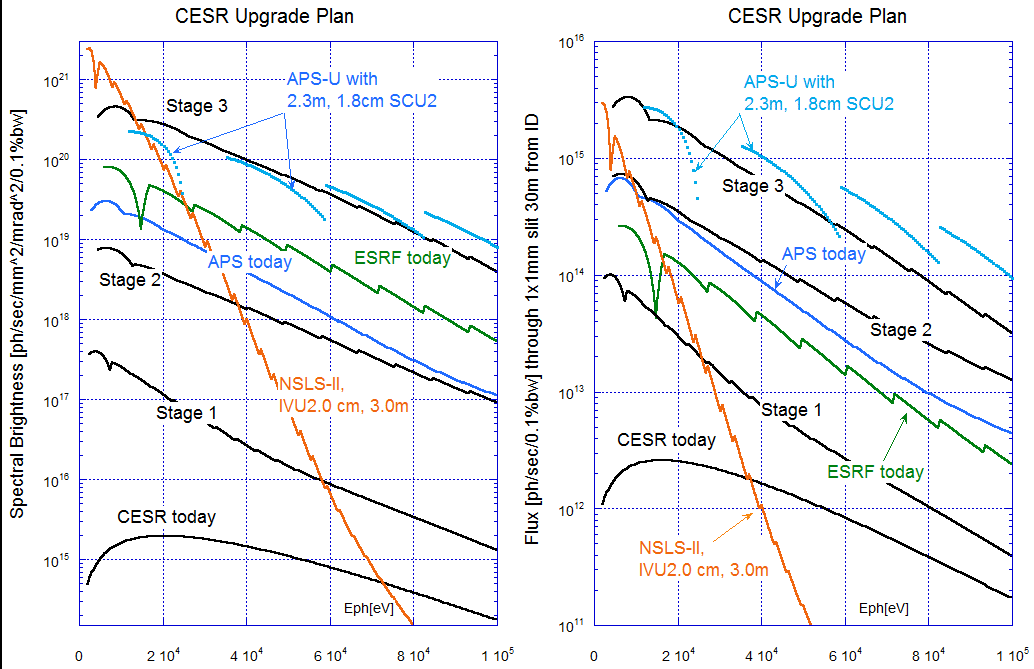
Future Vision for CHESS
CHESS is a leader in developing experimental techniques and technology using high energy, high flux x-ray beams, addressing topics ranging from metal fatigue to battery technology to high pressure materials science to the dynamics of biomolecules. This note describes a sequence of upgrades to CHESS and the CESR source that culminate in a 100,000-fold increase in spectral brightness and a 1000-fold increase in flux, on par with the best continuous duty hard x-ray sources world-wide. The spectral brightness and the flux through a pinhole 30m from the source for this sequence of upgrades and other leading sources are shown in the following.
Complete article here:
http://news.chess.cornell.edu/articles/2013/upgrade06042013.html
__________________________________________________

from Cornell Chronicle
Robotics for girls: A grad student's perspective
by Robin Bjorkquist
LEGO robotics? Not my thing.
When Lora Hine, director of educational programs at the Cornell Laboratory for Accelerator-Based Sciences and Education, asked me to co-coach a FIRST LEGO League (FLL) team this past fall, I hesitated. After all, when I was a kid, I would never have joined a robotics team. I had no interest in gadgets, technology or computer programming. I didn't even like science, which seemed to be all about memorizing facts.
Complete article here:
http://www.news.cornell.edu/stories/2013/12/robotics-girls-grad-students-perspective
Also (pdf)
__________________________________________________
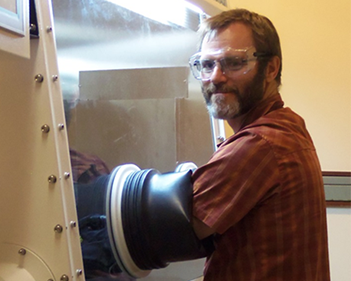
New Air-Free Glovebox Facility
New Specimen Prep Capability: CHESS has added an MBraun Labmaster glovebox to its suite of sample preparation facilities. The new glovebox provides users with an air and moisture free environment to store and prepare air sensitive samples for measurement at CHESS. Currently the glovebox provides a dry nitrogen environment; however, future upgrades will allow users to select nitrogen, argon, or helium environments dependent upon experimental needs.
Complete article here:
http://news.chess.cornell.edu/articles/2013/Ward12162013.html
__________________________________________________
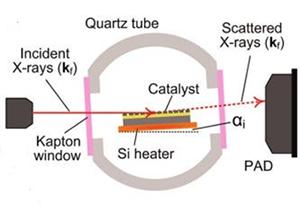
GISAXS/GIWAXS Furnace Ready For Action
Two user groups have used a new, custom-built glass tube furnace (Absolute Nano, Plymouth, MI), now available for general use at G1, for in situ studies of thermal behavior in thin films. The furnace is based on a design originally brought to G1 by John Hart’s group (MIT, then at University of Michigan) to study fabrication and kinetic effects in carbon nano-tube forests. The furnace uses highly doped, single-crystal silicon as the sample stage and heater. The temperature response is fast (~100C/second), accurate, and results in relatively little sample motion from thermal expansion. The furnace can be operated in air or under gas flow, and exchanging samples is straightforward and fast.
Complete article here:
http://news.chess.cornell.edu/articles/2013/Woll12162013.html
__________________________________________________
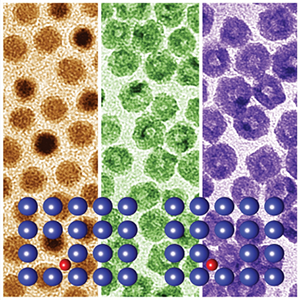
Hollow metal oxide nanoparticles produced from hot air
Facile synthesis of novel energy materials is necessary to tackle ever growing global energy demands. Cobalt oxide nanomaterials, in particular Co3O4 nanoparticles, are promising candidates for use in batteries, supercapacitors, and as electrocatalysts. The Robinson Group, in the Materials Science and Engineering department at Cornell University, has discovered important insights into methods to produce Co3O4 nanoparticles in a simple air oxidation process.
Complete article here:
http://news.chess.cornell.edu/articles/2013/Robinson12122013.html
Also in The Journal of Physical Chemistry here:
http://pubs.acs.org/doi/pdf/10.1021/jp402939e
__________________________________________________
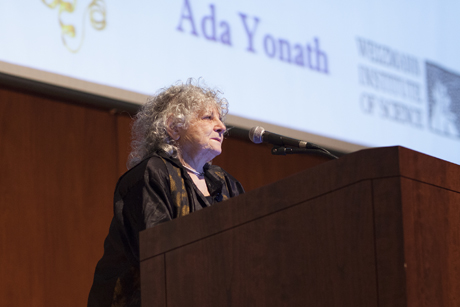
from Cornell Chronicle
Nobel laureate talks life expectancy, antibiotics
by Kara Beckman
One hundred may one day be the new 80, but it may be some time before living past 80 is a global standard for life expectancy, said Nobel laureate Ada Yonath, who delivered the 21st Efraim Racker Lecture in Biology and Medicine Nov. 14.
Ada Yonath is a professor of structural biology at Israel's Weizmann Institute of Science and co-recipient of the 2009 Nobel Prize in chemistry "for studies of the structure and function of the ribosome", along with Thomas Steitz of Yale University and Venkatraman Ramakrishnan of Cambridge. Starting in the mid-1980s, Ada Yonath was a frequent CHESS user, utilizing the newly constructed F1 station designed especially for macromolecular crystallography. Her extensive work on well-diffracting ribosome crystals, developing new approaches to mounting and cryocooling the samples, ultimately led to high-resolution structural models. Based on these models, new antibiotics, blocking the functioning of bacterial ribosomes, can be developed.
Complete article on the Cornell news site here:
http://www.news.cornell.edu/stories/2013/11/nobel-laureate-talks-life-expectancy-antibiotics
Also (pdf)
And previous articles on her work at CHESS:
http://news.chess.cornell.edu/articles/2009/YonathNobelPrize.html
http://www.news.cornell.edu/stories/2009/10/cu-synchrotron-played-role-nobel-winners-work
Also (pdf)
__________________________________________________
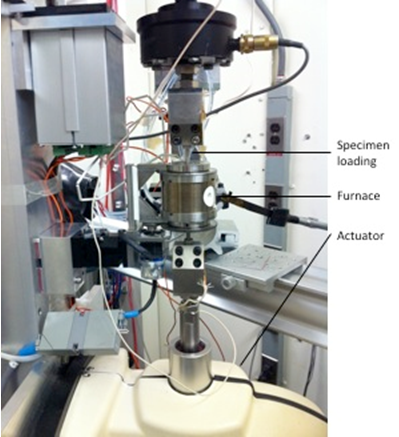
Creating real-world conditions in the laboratory for studying material behavior
Even though a metal seems like a strong material, everyone knows a metal paper clip can be broken quite easily by bending it back and forth ten or twenty times. This type of repetitive use, or cyclic loading, leads to failure of everything from auto components to door hinges to plastic utensils. In the engineering world, understanding failure and predicting failure of parts and materials is important, yet a complete understanding of the processes which lead to failure remains incomplete. In addition to worrying about failure, engineers are also concerned with system efficiency. Many systems, such as automobile engines, run more efficiently at higher operating temperatures. Improving efficiency has enormous technical and economical relevance.
Complete article here:
http://news.chess.cornell.edu/articles/2013/Oswald11192013.html
__________________________________________________
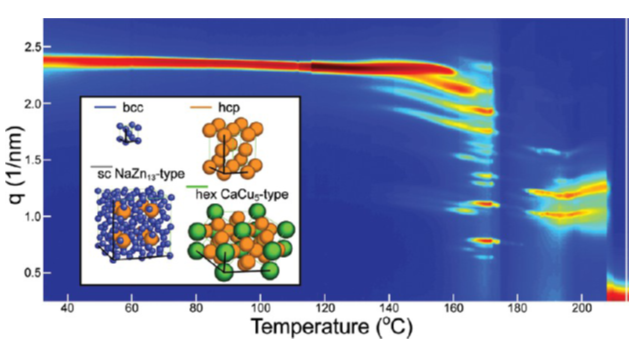
Highly organized fusion of nanoparticles upon heating
Ostwald ripening is a familiar effect – think of small water droplet condensing on a cold window pane. Sooner or later larger droplets form that will grow at the expanse of the smaller ones. Now imagine this random process proceeding in a highly organized way and with formation of symmetric patterns – such a behavior would seem rather unusual.
Complete article here:
http://news.chess.cornell.edu/articles/2013/KorgelFused11012013.html
__________________________________________________
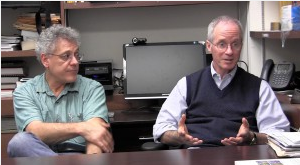
A History of Science: Cornell High Energy Synchrotron Source
Driving up Campus Road in the afternoon, you can see many varsity and club athletes practicing on Alumni Fields. But 40 feet underneath them and half a mile in circumference sits the Cornell High Energy Synchrotron Source.
CHESS is a circular particle accelerator that produces synchrotron radiation in the form of high-intensity, high-energy x-rays. These x-ray beams are instrumental for research in a wide variety of fields, including materials science, biology, and physics. The CHESS facility is connected with the Cornell Electron Storage Ring, which stores the beams of light accelerated by the synchrotron.
Complete article here:
http://cornellsun.com/blog/2013/10/30/a-history-of-science-cornell-high-energy-synchrotron-source/
Also (pdf)
__________________________________________________
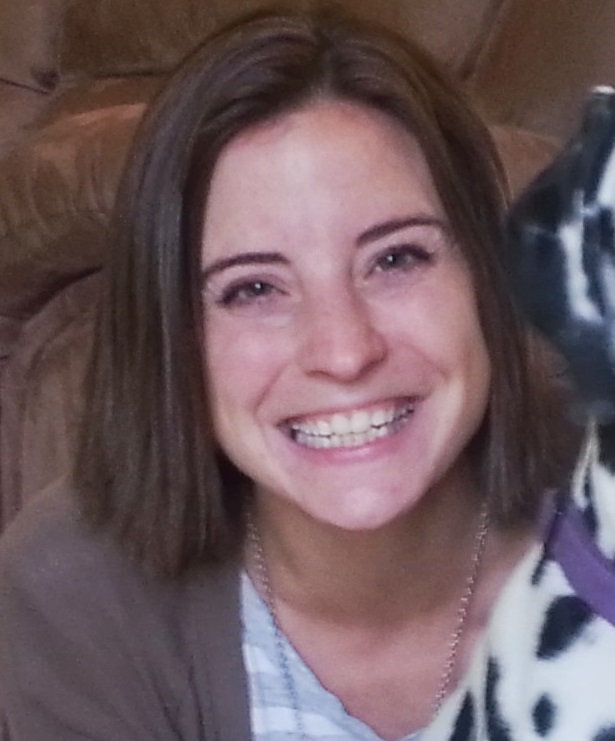
Student Wierman wins prestigious Etter Award
Jennifer (Jeney) Wierman, a rising star in biophysics at Cornell University and a member of the research group of Sol M. Gruner, was recently awarded the Margaret C. Etter Student Lecturer Award in the Synchrotron Radiation Scientific Group by the American Crystallographic Association. The award's namesake, Professor Margaret C. Etter (1943-1992), was a major contributor to the field of organic solid-state chemistry, and crystallography. In both academic and industrial realms, Etter found that involvement in the scientific community was very important, valuing relationships with colleagues and students. She focused much of her attention on mentoring and peer support. Following in this spirit, an award was established in her name in 2002 to recognize students for scientific innovation in crystallography.
Complete article here:
http://news.chess.cornell.edu/articles/2013/Wierman10172013.html
__________________________________________________
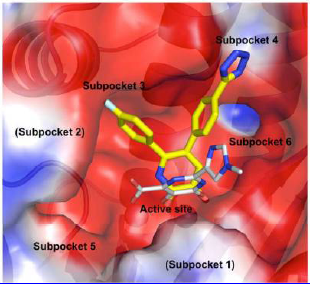
It's flu season
Influenza is a severe infectious disease, caused by RNA viruses, that can spread around the world in seasonal epidemics. Moreover, influenza can become pandemic when a new strain of the virus appears in humans, as has happened several time in the 20-th century (1918 H1N1 - Spanish flu, 1957 H2N2 - Asian flu, 1968 H3N2 - Hong Kong flu, 2009 H1N1 - swine flu). The recent outbreak of an unusual H7N9 strain, the emergence of drug-resistant variants of influenza A strain, and the adaptation of H5N1 for human-to-human transmission emphasize the urgent need for developing new broadly effective flu drugs. A group of researchers from Rutgers University led by Dr. E. Arnold has discovered and developed a new class of inhibitors targeting influenza endonuclease activity of the viral polymerase.
Complete article here:
http://news.chess.cornell.edu/articles/2013/Arnold101013.html
__________________________________________________
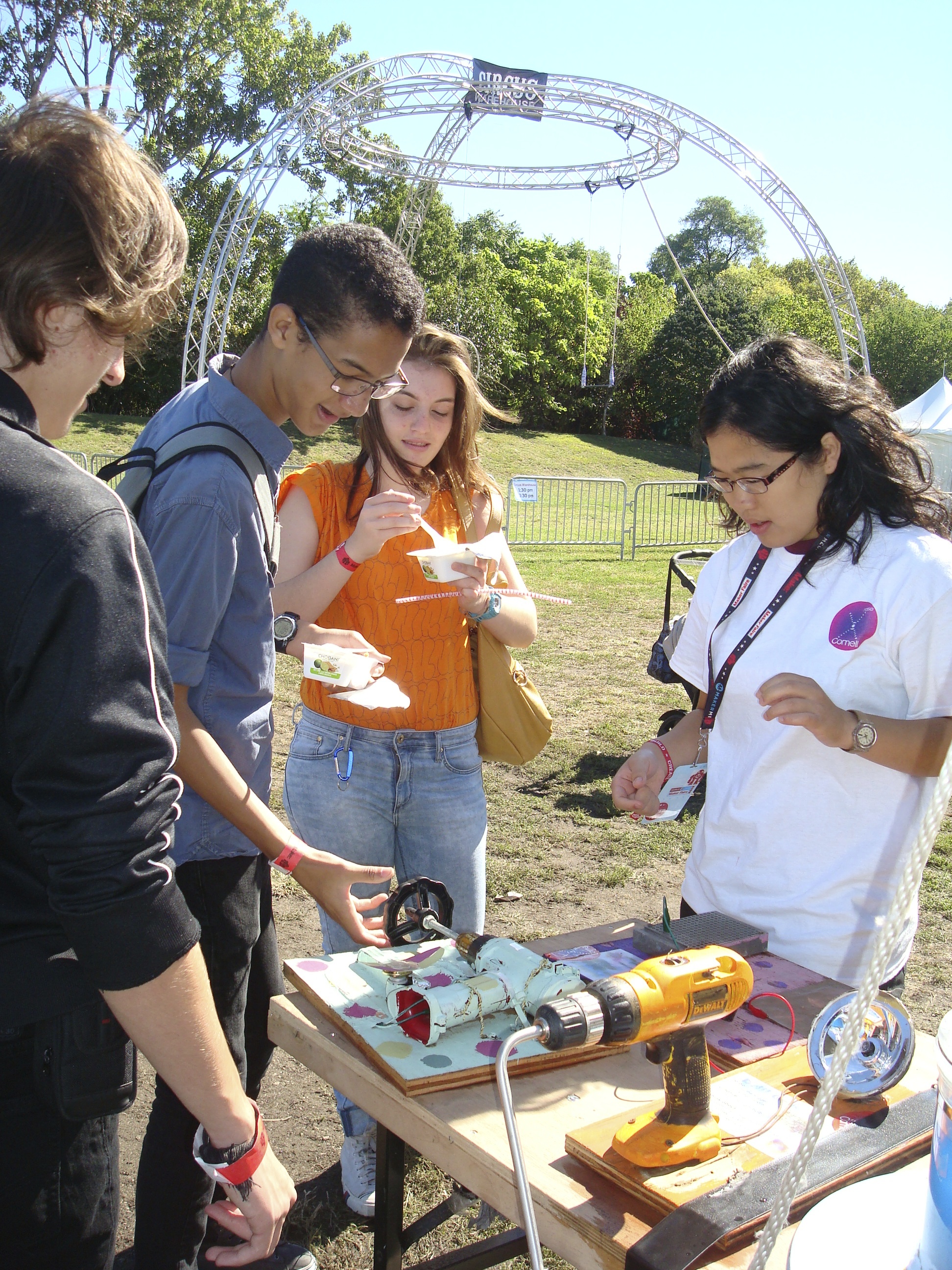
Xraise “Junk Genies” win big at 2013 Maker Faire
Xraise, the CLASSE (Cornell Laboratory for Accelerator-based ScienceS and Education) outreach program, traveled to the 2013 Maker Faire at the New York Hall of Science this fall. The Maker Faire is an annual event held by Maker Media (publisher of MAKE Magazine). They advertise their event as “The Greatest Show (and Tell) on Earth”. Many of the exhibits are interactive, with a focus on future technology and do-it-yourself projects. Mini-lectures are held throughout the weekend event, discussing topics ranging from microrobots to hacking to the art of design.
Complete article here:
http://news.chess.cornell.edu/articles/2013/JunkGenies10082013.html
__________________________________________________
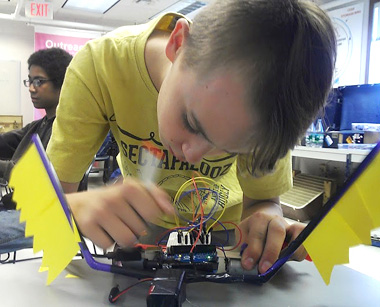
Revamp Camp connects kids, software engineering
From a robotic dog that barks and walks to an automatic cheese slicer, projects designed and built by middle school students at a Cornell-sponsored camp bolstered the students’ passion for computer programming and electronics engineering. Revamp Camp, Aug. 19-23, was co-sponsored by XRaise, the outreach program of the Cornell Laboratory for Accelerator-Based Sciences and Education, and Ithaca Generator, a community of inventors and engineers.
Complete Cornell Chronicle article here:
http://www.news.cornell.edu/stories/2013/09/revamp-camp-connects-kids-software-engineering
Also (pdf)
__________________________________________________
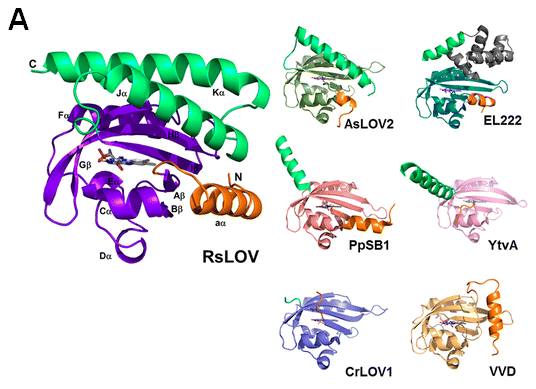
Proteins in LOVe with light
The acronym LOV stands for light, oxygen, or voltage – these are stimuli that can act on a LOV protein domain to produce a physiological response; this is one form of signal transduction. In the phototropic response of plants, for example, the amount of blue light shining on a leaf regulates the size of its stomatal apertures (stomata are vent holes for gas/water vapor). Another example is found in bacteria, where oxygen sensors containing LOV domains have been shown to regulate nitrogen fixation. LOV domains are structural homologues of the PAS superfamily, a group of diverse sensory proteins. Each LOV domain contains a non-covalently bound flavin mononucleotide (FMN) that performs reversible photochemistry [1]. The first X-ray crystal structure of a plant LOV domain was solved more than a decade ago by the Moffat group. That study answered many important questions regarding the binding geometry of the FMN cofactor and the possible course of the photochemical reaction [2]. In a more recent study, Cornell University professor Brian Crane and colleagues dissected the mechanism of light-induced subunit dissociation of RsLOV [3], a LOV domain photoreceptor from the photosynthetic Gram-negative bacteria Rhodobacter sphaeroides (Figure 1).
Complete article here:
http://news.chess.cornell.edu/articles/2013/Crane09172013.html
__________________________________________________
CHESS User Gaurav Giri receives the SSRL Melvin P. Klein Scientific Development Award
Gaurav Giri, known to his friends as Gino and
shown in the midst of action in Figure 1, is receiving the 2013
Melvin P. Klein Award for his work on solution shearing of organic
semiconducting molecules. The Klein Award recognizes outstanding
research accomplishments by students and postdocs at SSRL and
intends to promote dissemination of research results. Gino is
currently a Stanford graduate student working with Zhenan Bao in the Department of Chemical Engineering.
Read more...
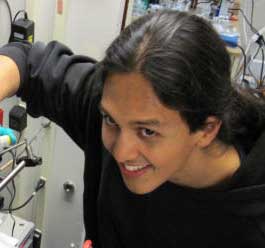
Figure 1 Gino preparing another in-situ real-time coating experiment at CHESS D1 station.
__________________________________________________
Scientists speed up search for new materials
Discovering new materials often involves
searching through hundreds, thousands, or millions of compounds to
find exciting new possibilities. Complicating this search further,
many new materials need to be heated or cooled in order to transform
them into useful products. A group of scientists from Harvard
and Cornell have developed a new technique that uses x-rays
to explore systematically and quickly an array of new materials
while also heating and cooling them at extremely fast rates.
Read more…
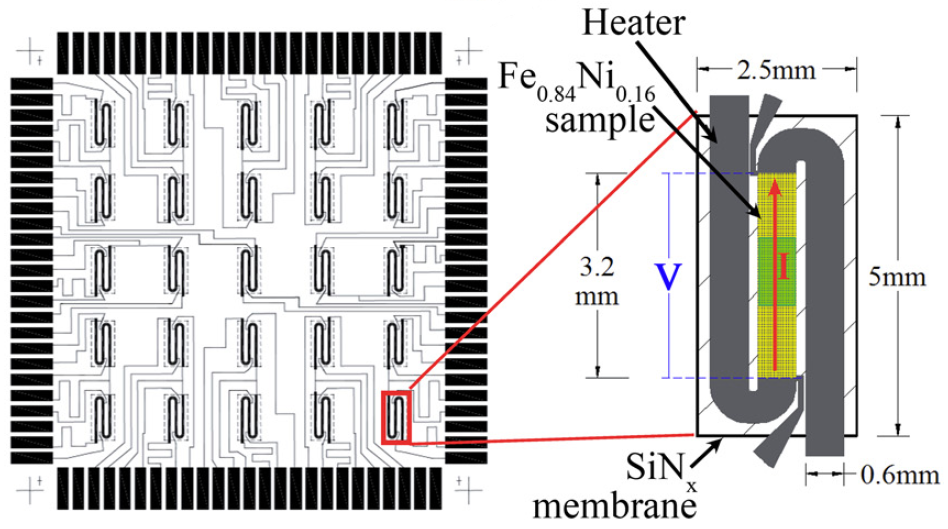
Figure 1 The metallization of the PnSC device is shown along with the detailed view of a single serpentine sensor that provides uniform sample heating over a broad range of scanning rates. The footprint of the x-ray beam is highlighted in green at center.
__________________________________________________
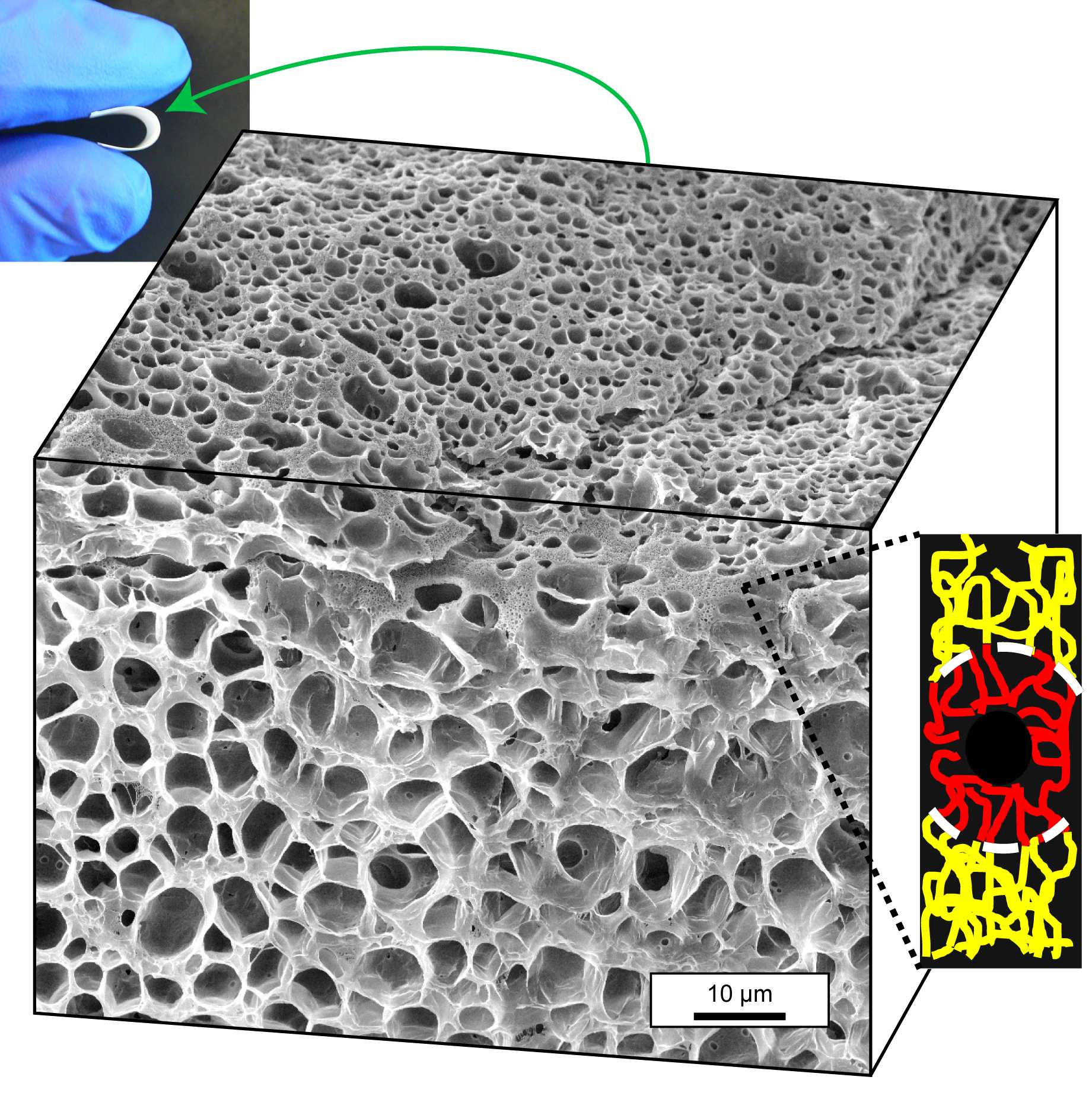
Simple, versatile polymer film synthesis method invented.
"Forming perfect porous polymer films is not enough; they need both large and small pores, and the process of making them needs to be simple, versatile and repeatable. Creatively combining already established techniques, Cornell materials researchers have devised a so-called hierarchical porous polymer film synthesis method that may help make these materials useful for applications ranging from catalysis to bioengineering." Read the Cornell Chronicle article by Anne Ju covering the research team was led by Ulrich Wiesner and graduate student Hiroaki Sai, first author on a paper reporting the results online in the journal Science, Aug. 2.
Complete Cornell Chronicle article here:
http://news.cornell.edu/stories/2013/08/versatile-polymer-film-synthesis-method-invented
Also (pdf)
Paper in Science (may require subscription) here:
http://www.sciencemag.org/content/341/6145/530.full
__________________________________________________

Shedding light on how plants defend themselves
Unlike humans, plants lack the immune system that’s required to fend off attacks from pathogens. Plants rely on a nonspecific response to deal with an outside attack (in humans, this type of response is known as innate immunity). Examples of these plant defense mechanisms include the production of pathogen-degrading enzymes, the production of chemicals (sometimes toxic), and deliberate cell suicide. In a recent study by the group of structural biology professor Michael Malkowski of SUNY Buffalo, new light was shed on the reaction mechanism and substrate specificity of an enzyme that belongs to the pathogen inducible oxygenase family [1]. As part of the host defense response in Arabidopsis thaliana, levels of the heme-containaing α-Dioxygenase (Ath α-DOX) are up-regulated to produce oxygenated fatty acids, chemicals which are often toxic to pathogens. Malkowski and coworkers report a high resolution crystal structure of Ath α-DOX, the first crystal structure of its kind.
Complete article here:
http://news.chess.cornell.edu/articles/2013/Malkowski07222013.html
__________________________________________________

Filming transcription at atomic resolution
RNA polymerase (RNAP) is the molecular Xerox machine that mediates information transfer from DNA to ribosomes for protein synthesis. Usually DNA and RNA polymerases are complex structures that require the presence of multiple protein co-factors. However, in this study Basu and Murakami dissect the reaction mechanism of a single subunit viral RNAP via a time-resolved soak-trigger-freeze X-ray crystallography method [1]. This study provides the final clues to the two-metal-ion reaction mechanism that was first proposed two decades ago by Steitz and Steitz [2].
Complete article here:
http://news.chess.cornell.edu/articles/2013/BasuMurakami07152013.html
__________________________________________________
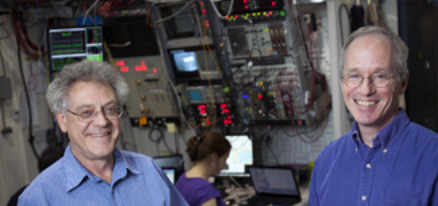
Gruner hands strong CHESS program to Brock
Sol Gruner is stepping down as director of the Cornell High Energy Synchrotron Source (CHESS) after nearly 17 years, but he is not retiring. Rather, he’s looking forward to continuing his active research programs in biophysics, condensed matter physics and x-ray detector technology. In a recent Cornell Chronicle story, writer Anne Ju interviews Gruner and his successor, Joel Brock, on Gruner’s contributions to CHESS and success building a talented staff and worldwide community of x-ray users. Brock takes over the CHESS program with aggressive near-term plans to upgrade x-ray source performance, and long-term aspirations to build a light source using new technology developed at Cornell called “Energy Recovery Linac.”
Read the Chronicle article here:
http://news.cornell.edu/stories/2013/06/living-vicariously-has-marked-gruners-time-chess
See archived article here.
__________________________________________________
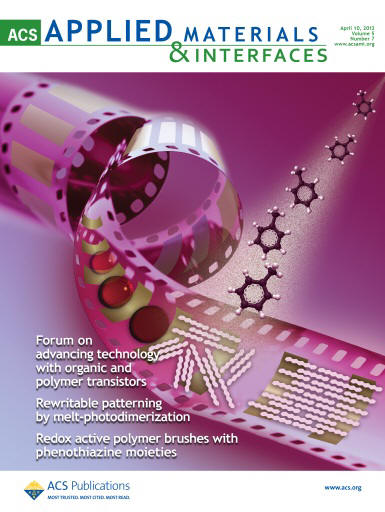
Organic Transistors: A Little Vapor Goes a Long Way
For the industrial production of flexible electronics for the consumer market, post-deposition annealing is an important processing step. The purpose of the annealing step is to optimize performance in printed organic circuits. A team of researchers led by Aram Amassian at King Abdullah University of Science and Technology and the Cornell High Energy Synchrotron Source has studied how the improvement of electronic performance is related to the development of microsctructure of the material during solvent annealing.
Complete article here:
http://news.chess.cornell.edu/articles/2013/Amassian05282013.html
__________________________________________________
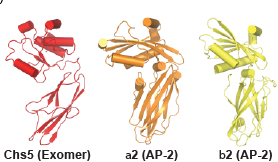
The Crystal Structure of Exomer Reveals Novel Domain Required for Trafficking
The exomer is referred to as a cargo adaptor, for its role of sorting cargo, such as Chs3, into vesicles. The Fromme group at Cornell University solved the crystal structure of a tetrameric exomer complex at 2.75 Å resolution and the results are reported in EMBO Journal.
Complete article here:
http://news.chess.cornell.edu/articles/2013/Fromme04052013.html
__________________________________________________
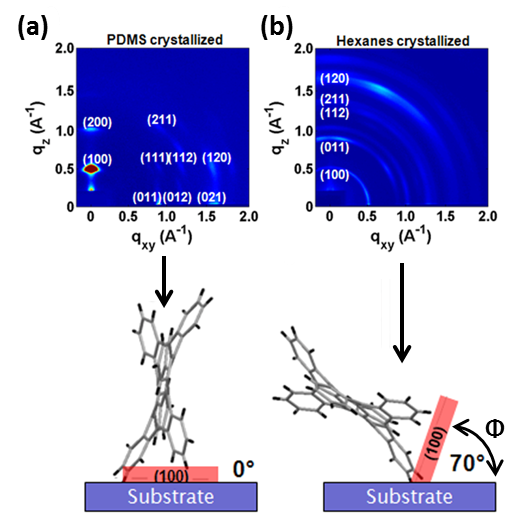
Pi stacking improves organic semiconductors
Flexible electronic devices, such as plastic displays, wearable radio frequency identification tags, and roll up solar panels, based on pi-bonded organic semiconductors have become highly desirable due to their light weight and high level of durability. Recently a group of researchers from Princeton University, led by Professor Yueh-Lin Loo, demonstrated the ability to tune the molecular orientation of organic thin-films through post-deposition treatments and independent of surface treatments, resulting in organic semiconductor thin-films with desirable properties for organic electronics applications.
Complete article here:
http://news.chess.cornell.edu/articles/2013/Loo04252013.html
__________________________________________________
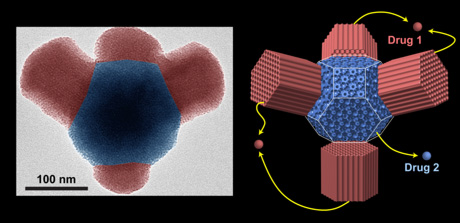
Compartmental Nanosponges
Cornell Researchers led by Materials Science and Engineering professor Ulrich Wiesner have developed a method based on sol-gel chemistry and self assembly to produce compartmentalized sponge-like nanoparticles. The technology could be used to provide safer drug delivery or develop new approaches to catalysis. The group was also able to connect multiple cores with tube-like bridges between them, suggesting that their method could be used to create complex nanoparticle architectures.
Complete summary available here:
http://www.news.cornell.edu/stories/2013/04/nano-compartments-may-aid-drug-delivery-catalyst-design
Also (pdf)
Original publication available here:
http://www.sciencemag.org/content/340/6130/337.abstract
__________________________________________________
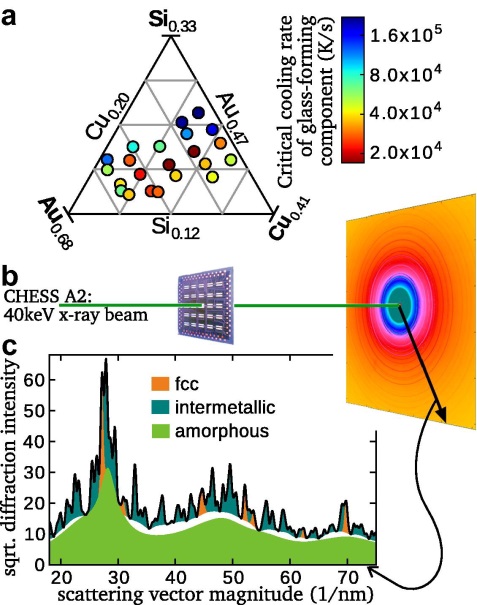
A new approach to the glass transition
Most materials freeze at a well-defined temperature into a mass of tiny crystals. Glass is different – over a narrow range of temperature, known as the glass transition, the melt solidifies but retains an atomic structure that is very similar to that of the liquid melt. Now a group of researchers from Harvard University, led by Professor Joost Vlassak, and the Cornell High Energy Synchrotron Source have combined efforts to develop new experimental capabilities with the potential to provide new insights into the nature of the glass transition.
Complete article here:
http://news.chess.cornell.edu/articles/2013/Vlassak04232013.html
__________________________________________________
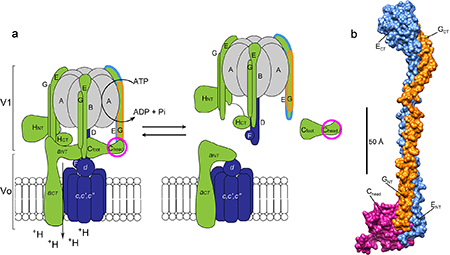
Understanding the Spring-Loaded Rotary Motor Within Living Cells
The vacuolar ATPase is a large, multi-protein enzyme complex that pumps acid (protons) across lipid membranes in all animal and plant cells. The activity of the complex is regulated by a unique mechanism in which the part of the complex responsible for ATP hydrolysis detaches from the membrane embedded proton channel in a process referred to as reversible dissociation What is the structural basis for the reversible dissociation?
Complete article here:
http://news.chess.cornell.edu/articles/2013/Wilkens04162013.html
__________________________________________________
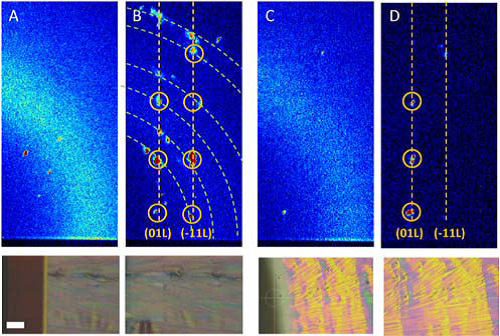
Spreading the Butter on the Toast Just So – High-Performance Organic Transistors by Novel Deposition Technique
Organic transistors are being hotly investigated for flexible and inexpensive “plastic electronics” applications, such as automobile dashboards and smart tags. A joint team of scientists from the Cornell High Energy Synchrotron Source, King Abdullah University of Science and Technology in Saudi Arabia, and Stanford University just reported an experimental break-through for studying the structural evolution of organic transistor layers during the coating process in-situ and in real-time with x-ray scattering.
Complete article here:
http://news.chess.cornell.edu/articles/2013/Smilgies04112013.html
__________________________________________________
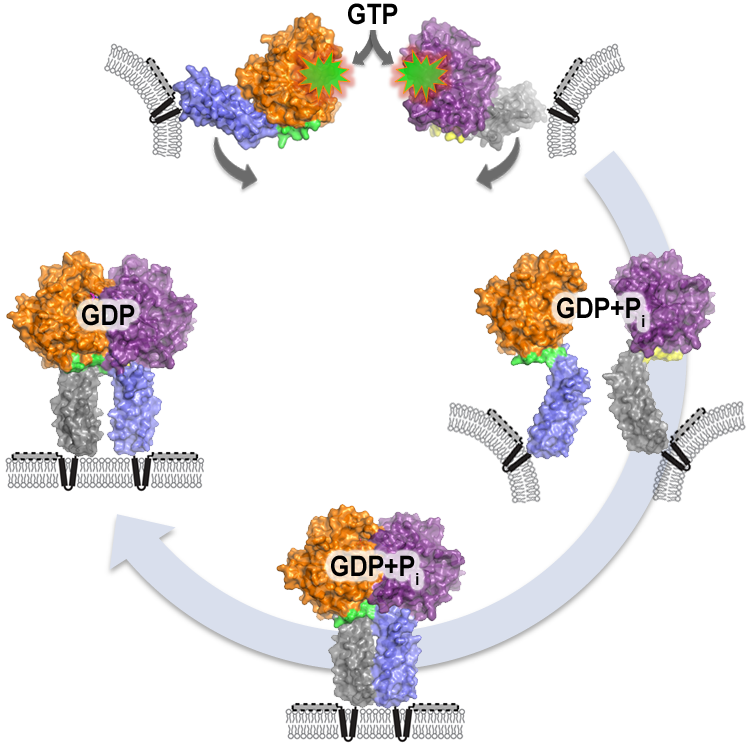
At last: Insights into membrane fusion and disease
Within every cell of the human body lies an intricate network of membrane tubules and sheets tasked with orchestrating the processing of many of the molecules necessary to keep the cell alive. This network, called the endoplasmic reticulum, employs many different types of proteins to accomplish this task. However, when this structure breaks down, it can result in diseases.
Complete article here:
http://news.chess.cornell.edu/articles/2013/Sondermann04112013.html
__________________________________________________

Expo features flyers, hoverers, soarers and wind catchers
From viewing 19-foot hang gliders to making 19-inch walk-along gliders, visitors to the first Aeronautics/Alternative Energy Expo in Clark Hall March 28 got to experience the real challenge of catching a breeze.
Complete article from the Cornell Chronicle here:
http://www.news.cornell.edu//stories/2013/04/expo-features-flyers-hoverers-soarers-and-wind-catchers
Also (pdf)
__________________________________________________
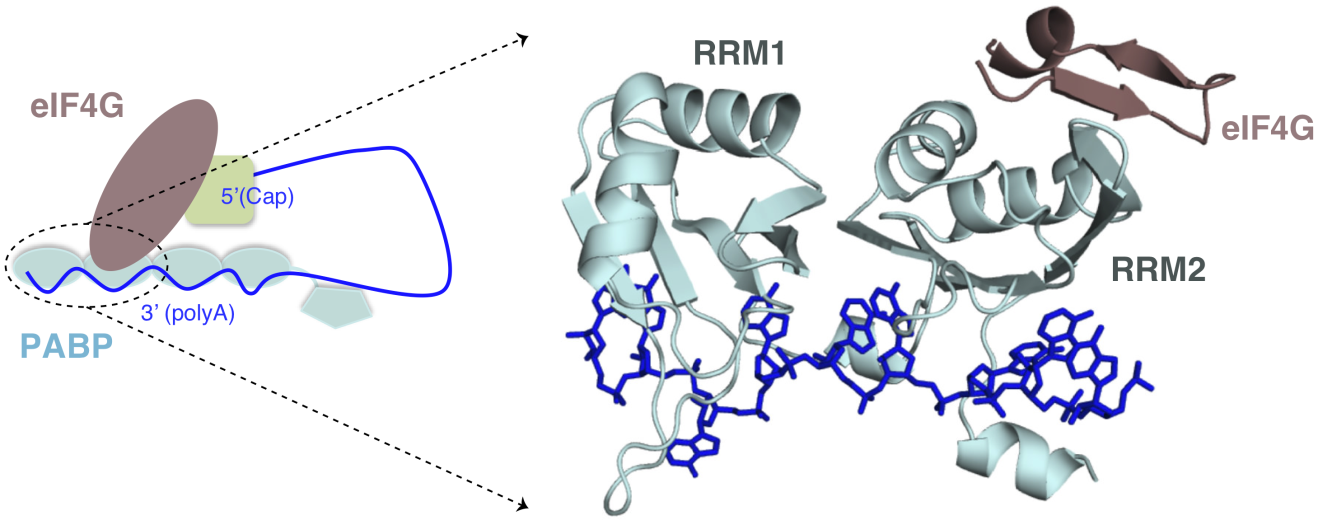
Insights on regulation of the RNA-protein complex involved in protein synthesis
Cells synthesize proteins by transcribing genetic information from DNA onto messenger RNA molecules. The Gehring group and co-workers report in the journal Molecular Cell how they used X-ray methods to elucidate how this transcription process works.
Complete article here:
http://news.chess.cornell.edu/articles/2013/Gehring03282013.html
__________________________________________________
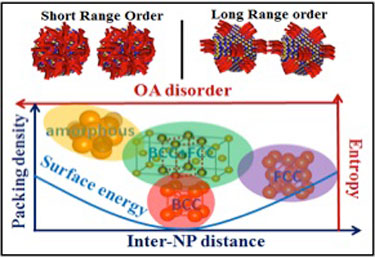
How do superlattices grow?
A team of scientists from Cornell University in the US, the Max Planck Institute of Colloids and Interfaces in Potsdam in Germany, and the University of Hamburg, also in Germany, are the first to have studied how superlattices form.
Complete article from nanotechweb.org here:
http://nanotechweb.org/cws/article/tech/52719
Or see the (pdf)
from
http://nanotechweb.org/cws/article/tech/52719
__________________________________________________
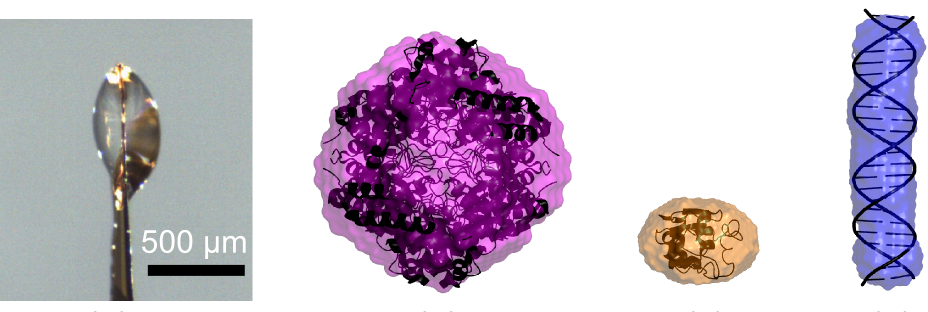
Cryo-SAXS breaks the radiation damage limit
Complete article here:
http://news.chess.cornell.edu/articles/2013/Meisburger03052013.html
__________________________________________________
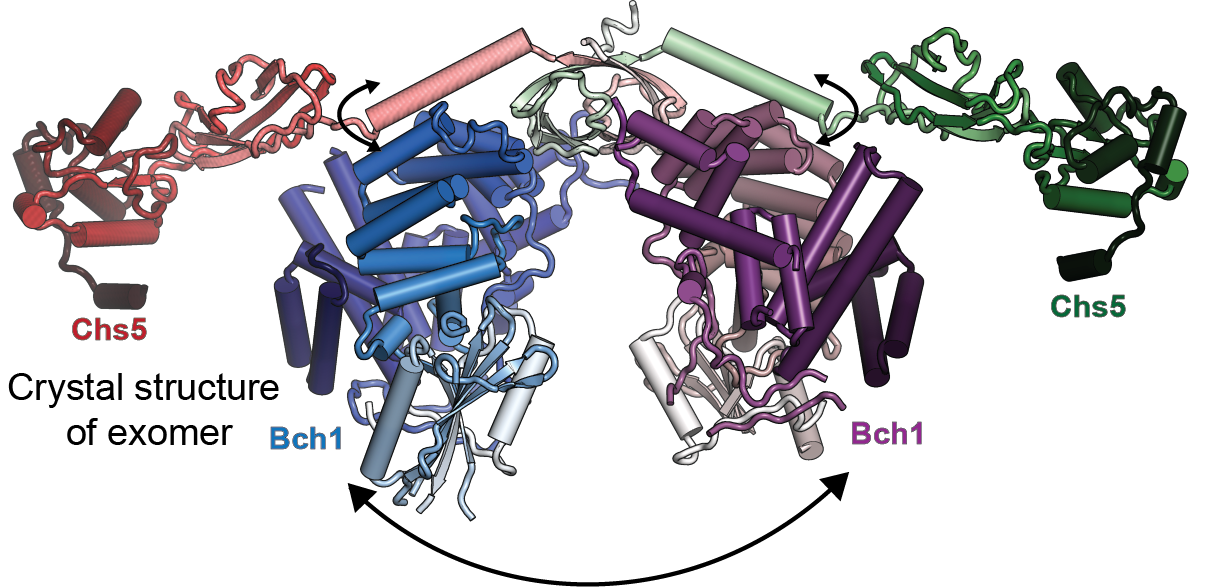
Sorting proteins to the right address at the cellular post office
By comparing small-angle X-ray scattering (SAXS) and X-ray crystallographic data, the Fromme group of Cornell University finds that this motif exhibits an unexpected flexibility in solution with implications for exomer function as a cargo adaptor in a heterogenous membrane milieu.
Complete article here:
http://news.chess.cornell.edu/articles/2013/Richardson02192013.html
__________________________________________________

Image
courtesy of: LEPP, Cornell University
NCUWiP (Women in Physics) Conference
A Cornell conference for women in physics and other physical sciences drew close to 200 participants, Jan. 18-20.
Organized by Cornell students, the Northeast Conference for Undergraduate Women in Physics was one of six events happening simultaneously throughout the U.S. About 140 female undergraduates and 40 invited guests, including speakers, panelists and faculty members, attended the Cornell event.
Complete article here:
http://www.news.cornell.edu/stories/Jan13/womenPhysics.html
Also (pdf)
__________________________________________________
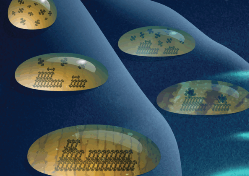
Shake It Up – Insights on printing thin films for organic electronics devices
The production of thin films underlays much of modern technology, from flexible flat screen monitors to future applications of “plastic electronics” in cases such as luminaires, smart tags, and solar energy conversion. While the common process of vacuum deposition of thin film materials onto substrates is well understood, much less is known about how a molecular thin film forms from a liquid solution. This is important because liquid solution methods will enable fast, inexpensive printing of electronics, solar cells and batteries.
Complete article here:
http://news.chess.cornell.edu/articles/2013/Amass01172013.html
__________________________________________________
Women in Science
Former NFL Lineman and Cornell Professor Matt Miller (CHESS Faculty Liaison) talks engineering with his daughter Chaney in a video for the Cornell Institute for Women in Science.
See the Video: http://news.chess.cornell.edu/articles/2013/MillerWinS.html
__________________________________________________
Cornell University Partners in Sustainability Award
Sustainable Tompkins recognized community sustainability efforts and Cornell received 59 "Signs of sustainability" certificates for 2012! One being given to the CLASSE Outreach Program - XRaise for their "Catch the Breeze" wind turbine design competition.
See the Sustainable Campus online article: http://www.sustainablecampus.cornell.edu/blogs/news/posts/cornell-awarded-59-signs-of-sustainability
Or see the (pdf)
__________________________________________________
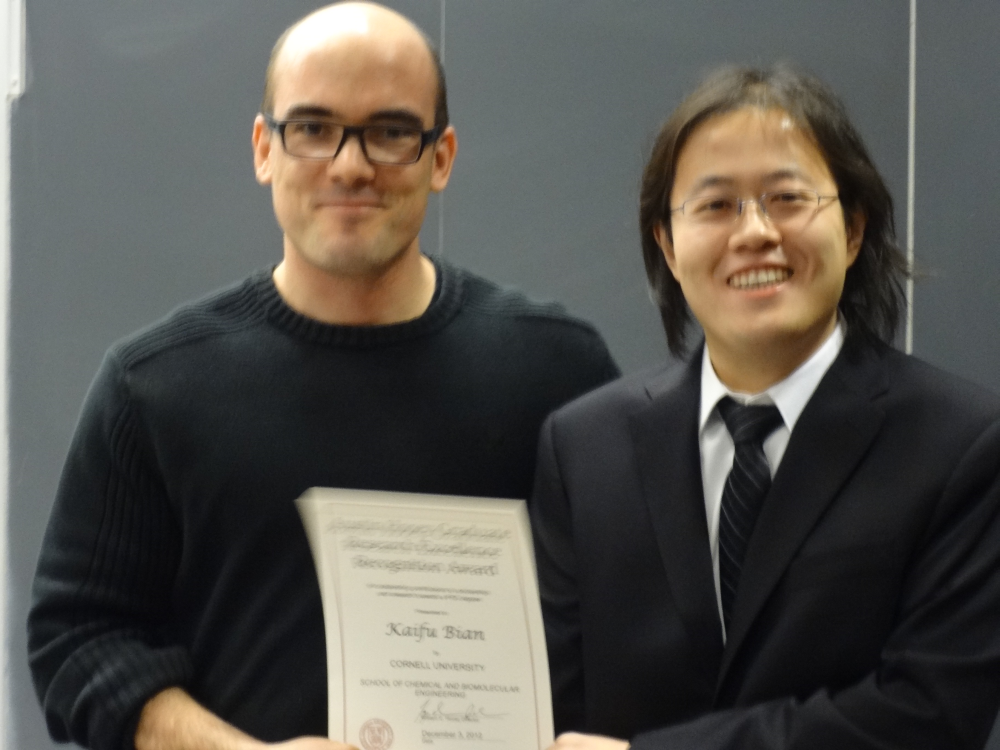
Austin Hooey Award for CHESS Graduate Student User Kaifu Bian
Cornell chemical engineering student Kaifu Bian was recently awarded the 2012 Austin Hooey Award for Outstanding Thesis Research. The Hooey Graduate Research Excellence Recognition Award is the highest award given to a graduate student by Cornell’s School of Chemical and Biomolecular Engineering. This award recognizes excellence in graduate research and service to the research group, department and community. Kaifu’s research focused on fundamental processing-structure-property relationships of nanocrystal assemblies as designer solids.
Complete article here:
http://news.chess.cornell.edu/articles/2013/Kaifu01022013.html
